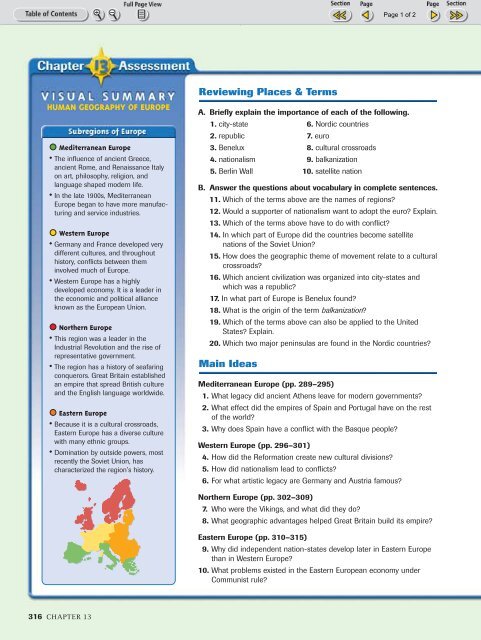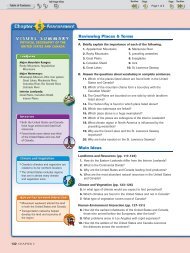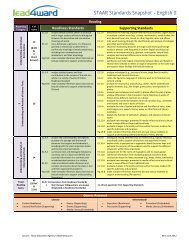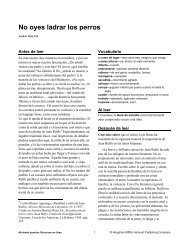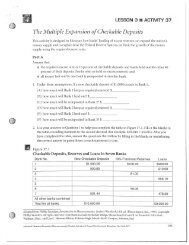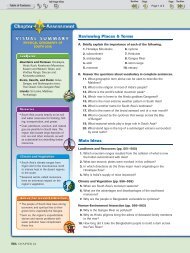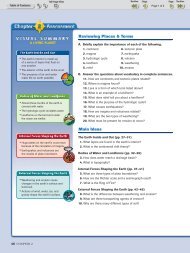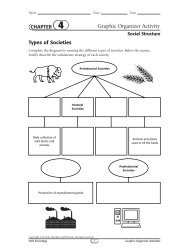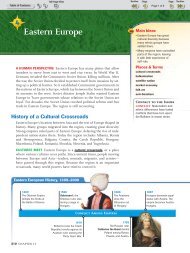Reviewing Places & Terms Main Ideas
Reviewing Places & Terms Main Ideas
Reviewing Places & Terms Main Ideas
You also want an ePaper? Increase the reach of your titles
YUMPU automatically turns print PDFs into web optimized ePapers that Google loves.
316-317-Chapter13 10/16/02 10:55 AM Page 316<br />
HUMAN GEOGRAPHY OF EUROPE<br />
Mediterranean Europe<br />
• The influence of ancient Greece,<br />
ancient Rome, and Renaissance Italy<br />
on art, philosophy, religion, and<br />
language shaped modern life.<br />
• In the late 1900s, Mediterranean<br />
Europe began to have more manufacturing<br />
and service industries.<br />
Western Europe<br />
• Germany and France developed very<br />
different cultures, and throughout<br />
history, conflicts between them<br />
involved much of Europe.<br />
• Western Europe has a highly<br />
developed economy. It is a leader in<br />
the economic and political alliance<br />
known as the European Union.<br />
Northern Europe<br />
• This region was a leader in the<br />
Industrial Revolution and the rise of<br />
representative government.<br />
• The region has a history of seafaring<br />
conquerors. Great Britain established<br />
an empire that spread British culture<br />
and the English language worldwide.<br />
Eastern Europe<br />
• Because it is a cultural crossroads,<br />
Eastern Europe has a diverse culture<br />
with many ethnic groups.<br />
• Domination by outside powers, most<br />
recently the Soviet Union, has<br />
characterized the region’s history.<br />
<strong>Reviewing</strong> <strong>Places</strong> & <strong>Terms</strong><br />
A. Briefly explain the importance of each of the following.<br />
1. city-state 6. Nordic countries<br />
2. republic 7. euro<br />
3. Benelux 8. cultural crossroads<br />
4. nationalism 9. balkanization<br />
5. Berlin Wall 10. satellite nation<br />
B. Answer the questions about vocabulary in complete sentences.<br />
11. Which of the terms above are the names of regions?<br />
12. Would a supporter of nationalism want to adopt the euro? Explain.<br />
13. Which of the terms above have to do with conflict?<br />
14. In which part of Europe did the countries become satellite<br />
nations of the Soviet Union?<br />
15. How does the geographic theme of movement relate to a cultural<br />
crossroads?<br />
16. Which ancient civilization was organized into city-states and<br />
which was a republic?<br />
17. In what part of Europe is Benelux found?<br />
18. What is the origin of the term balkanization?<br />
19. Which of the terms above can also be applied to the United<br />
States? Explain.<br />
20. Which two major peninsulas are found in the Nordic countries?<br />
<strong>Main</strong> <strong>Ideas</strong><br />
Mediterranean Europe (pp. 289–295)<br />
1. What legacy did ancient Athens leave for modern governments?<br />
2. What effect did the empires of Spain and Portugal have on the rest<br />
of the world?<br />
3. Why does Spain have a conflict with the Basque people?<br />
Western Europe (pp. 296–301)<br />
4. How did the Reformation create new cultural divisions?<br />
5. How did nationalism lead to conflicts?<br />
6. For what artistic legacy are Germany and Austria famous?<br />
Northern Europe (pp. 302–309)<br />
7. Who were the Vikings, and what did they do?<br />
8. What geographic advantages helped Great Britain build its empire?<br />
Eastern Europe (pp. 310–315)<br />
9. Why did independent nation-states develop later in Eastern Europe<br />
than in Western Europe?<br />
10. What problems existed in the Eastern European economy under<br />
Communist rule?<br />
316 CHAPTER 13
316-317-Chapter13 10/16/02 10:55 AM Page 317<br />
Critical Thinking<br />
1. Using Your Notes<br />
Use your completed chart to answer these questions.<br />
Western<br />
Northern<br />
Europe<br />
Eastern<br />
Mediterranean<br />
a. What similarities exist between the ways the Roman<br />
Empire and the British Empire influenced other<br />
regions of the world?<br />
b. In what ways are Eastern Europe and Northern<br />
Europe different?<br />
2. Geographic Themes<br />
a. LOCATION Do you think the location of France and<br />
Germany relative to the rest of Europe is a<br />
geographic advantage or disadvantage? Explain.<br />
b. MOVEMENT What geographic reason might<br />
account for the fact that Spain and Great Britain<br />
colonized much of the Americas?<br />
Geographic Skills: Interpreting Maps<br />
3. Identifying Themes<br />
Explain which countries were the first to develop industry<br />
and which developed industry later. If you identify those<br />
countries on a map, what spatial patterns do you see?<br />
Which geographic themes relate to your answer?<br />
4. Seeing Patterns<br />
How did ancient migrations affect the pattern of where<br />
certain languages are spoken in Europe today? Give<br />
examples.<br />
5. Making Inferences<br />
Millions of Europeans have migrated to other parts of the<br />
world. What are some geographic factors that you think<br />
might have encouraged this?<br />
Additional Test Practice,<br />
pp. S1–S37<br />
TEST PRACTICE<br />
CLASSZONE.COM<br />
EUROPE<br />
A Divided Germany<br />
Use the map to answer the following<br />
questions.<br />
1. PLACE How did the size of West Germany<br />
compare with that of East Germany?<br />
2. LOCATION In which of the two countries<br />
was the city of Berlin located?<br />
3. LOCATION Which of the two Germanys<br />
was closer to the Soviet Union?<br />
West Germany was divided into<br />
several zones after World War II. Use<br />
a history book or historical atlas to<br />
learn which three countries controlled<br />
those zones. Create a historical map<br />
showing the zones.<br />
FRANCE<br />
BELGIUM<br />
LUXEMBOURG<br />
North<br />
Sea<br />
NETHERLANDS<br />
Bern<br />
Hamburg<br />
Amsterdam<br />
WEST<br />
GERMANY<br />
Bonn<br />
SWITZERLAND<br />
DENMARK<br />
0° 10°E<br />
20°E<br />
0 100 200 miles<br />
0 100 200 kilometers<br />
Azimuthal Equidistant Projection<br />
LIECHTENSTEIN<br />
ITALY<br />
EAST<br />
GERMANY<br />
Berlin<br />
Prague<br />
POLAND<br />
CZECHOSLOVAKIA<br />
AUSTRIA<br />
B altic<br />
Sea<br />
50°N<br />
Border between East<br />
and West Germany, 1949<br />
National capital<br />
Use the links at classzone.com to do research about the<br />
population of a single European country. Look for such<br />
information as age distribution, religions, ethnic or<br />
minority groups, and literacy rates.<br />
Creating a Multimedia Presentation Plan a presentation<br />
to share your findings with the class. Include a<br />
population pyramid, pie graphs, and other graphs. List the<br />
Web sites that were your sources.<br />
Diversity, Conflict, Union 317


